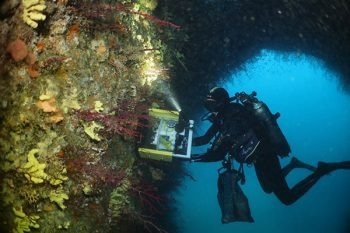Beneath the ocean's surface, marine organisms release imperceptible molecules that carry valuable information. Some of these chemical signals unveil the presence of nearby creatures, while others may hold the potential for future use in medications.
 This proof-of-concept device “smells” seawater by trapping dissolved compounds that sponges release. Image Credit: ACS Central Science
This proof-of-concept device “smells” seawater by trapping dissolved compounds that sponges release. Image Credit: ACS Central Science
Recently, scientists in ACS Central Science have introduced a proof-of-concept device that “sniffs” seawater, and captures dissolved compounds for analysis. The team demonstrated the system's ability to efficiently concentrate molecules found in underwater caves, suggesting its potential for drug discovery in delicate ecosystems like coral reefs.
Comparing a drop of seawater to a spoonful of dilute soup, it resembles an intricate blend of dissolved molecules from various ocean-dwelling organisms. To discern the contents of this mixture, scientists must capture and concentrate these molecules.
However, many underwater environments, particularly those harboring unique and potentially bioactive compounds, are under threat. In light of this, Thierry Pérez, Charlotte Simmler, and their team aimed to create an underwater instrument capable of capturing and enriching dissolved compounds produced by sponges or other marine organisms without causing harm to their source or the surrounding ecosystem.
The team engineered a waterproof device designed for easy use by underwater divers. This apparatus could pump seawater through disks with a texture and thickness resembling makeup remover pads. These disks effectively adsorbed dissolved molecules, ready for subsequent analysis.
Named the In Situ Marine moleculE Logger, or "I-SMEL," the researchers tested it in 65-foot-deep Mediterranean Sea caves populated by various massive sponges. After sampling the water, they scrutinized the captured compounds using mass spectrometry. The compounds exhibited diverse elemental compositions, with many featuring unknown molecular structures—a promising indicator for the potential discovery of new natural products.
In their detailed examination of three sponge species, the researchers identified various metabolites, including brominated alkaloids and furanoterpenoids, captured from seawater. Interestingly, the system not only detected but also concentrated compounds released by sponges.
For instance, aeroplysinin-1 was found to be approximately 20 times more abundant in seawater extracts compared to a yellow cave-sponge extract. The researchers suggest that "I-SMEL" provides a non-invasive means of capturing molecules of interest, offering insights into an ecosystem's health and detecting novel molecules for future drug discovery efforts. Their next objective is to modify the device for autonomous, long-term seawater filtration and remote operation in deeper waters.
Journal Reference:
Mauduit, M., et al. (2023) In Situ Capture and Real-Time Enrichment of Marine Chemical Diversity. ACS Central Science. doi.org/10.1021/acscentsci.3c00661.